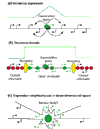Gene expression neighborhoods
- PMID: 12144705
- PMCID: PMC117247
- DOI: 10.1186/1475-4924-1-4
Gene expression neighborhoods
Abstract
The finding that neighboring eukaryotic genes are often expressed in similar patterns suggests the involvement of chromatin domains in the control of genes within a genomic neighborhood.
Figures

References
-
- Tabata T. Genetics of morphogen gradients. Nat Rev Genet. 2001;2:620–630. - PubMed
-
- Pannuti A, Lucchesi JC. Recycling to remodel: evolution of dosage-compensation complexes. Curr Opin Genet Dev. 2000;10:644–650. - PubMed
-
- Caron H, van Schaik B, van der Mee M, Baas F, Riggins G, van Sluis P, Hermus MC, van Asperen R, Boon K, Voute PA, et al. The human transcriptome map: clustering of highly expressed genes in chromosomal domains. Science. 2001;291:1289–1292. - PubMed
-
- Lercher MJ, Urrutia AO, Hurst LD. Clustering of housekeeping genes provides a unified model of gene order in the human genome. Nat Genet. 2002;31:180–183. - PubMed
Publication types
MeSH terms
LinkOut - more resources
Full Text Sources
Molecular Biology Databases

